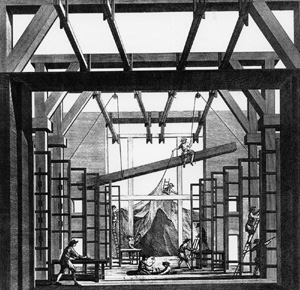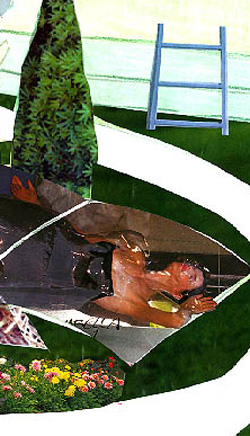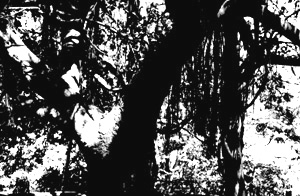ONTOLOGIE
THE ONTOLOGICAL DREAM
THE END (& THE BEGINNING & THE END) - "Perhaps in every field but most of all in language, use is a polar gesture: on the one hand, appropriation and habit; on the other, expropriation and nonidentity. And 'usage' (in its whole semantic field, as both 'to use' and 'to be used to') is the perpetual oscillation between a homeland and an exile -- dwelling." --Giorgio Agamben, "Expropriated Manner", The End of the Poem (1996/1999)
 FRAGMENTS - The Ontological Argument, one of the craftiest of philosophical arguments (from Anselm to Lévinas) ... A construction of extreme liminality ... A landscape of mirrors ... The irreducible collision of things and concepts ... The beginning and end of the world (a simultaneous affect) ... The simulation of the very ground of Being (Being-in-Being) ... The entire edifice of signifying chains illuminated by the ghost "nature" of consciousness ... The quaking (primal) ground beneath our feet ...
FRAGMENTS - The Ontological Argument, one of the craftiest of philosophical arguments (from Anselm to Lévinas) ... A construction of extreme liminality ... A landscape of mirrors ... The irreducible collision of things and concepts ... The beginning and end of the world (a simultaneous affect) ... The simulation of the very ground of Being (Being-in-Being) ... The entire edifice of signifying chains illuminated by the ghost "nature" of consciousness ... The quaking (primal) ground beneath our feet ...Everything becomes "suture" ... Things (objects) and Being (subjects) interact only insofar as a place is permitted/created for interaction ... The interaction is perennially problematized by consciousness itself ... The problem of Being (and subject-object relations) circles itself ... The circle (language) remains (becomes) haunted ... This "haunting" is the great conundrum of absence and presence ... Absence and presence illuminate experience through the act of "suture" ... Suture, a stitching together of images (and states), underwrites the construction of the World ... The World begins and ends with the "gaze into the mirror" of the self (Lacan) ... Self emerges from the gap in-between things ... This gap, horizon (distance), is anathematized/deified/defined/defiled as "landscape" ...
THE SUTURE - In Godard's King Lear (1987) one of the closing images is that of "stitching together" an unwound (broken) spool of film. In Godard's JLG/JLG (1995) the film ends with the director hiring a blind film editor. In Kubrick's 2001 (1968) the beginning and the end (of the film and time) merge in a space devoid of particulars (where the generic lives and audibly "breathes"/pulsates) ... In Tarkovsky's Mirror (1974) a child gazes into a mirror, seeing himself seeing himself, and, as if to close the autistic non-rapport of the Narcissistic, the mirror becomes the means of epiphany, of the visionary experience, by reflecting not only self but world (or Self-in-the-World). The conceit is repeated repeatedly ... A child drinks from a picture of milk, gazing at himself drinking from a picture of milk, alone in the ancestral house (his grandfather's house) windswept with an array of ghostly lace curtains suspended in the space of the room ... The elements penetrate the open room, as a storm passes, and the world outside (always brushing up against the world within) invades the privileged interior of being.
In Tarkovsky's Nostalghia (1983), a Russian poet, wandering Tuscany in search of traces of an 18th-century Russian musician, finds traces instead of a primordial condition (interface) between individuality (memory) and things -- landscape overruns the makeshift conditions of the world. The poet's beautiful Italian interpreter reads from a letter written by the musician Sosnovsky. In the letter, the 18th-century wanderer tells of a dream wherein he is staging an opera and he is slowly turning to stone, a statue set upon a pedestal. Tarkovsky "pictures" the ontological "dream" gone awry -- that which haunts consciousness and that which always becomes in cinema the secret protagonist. This "gone awry" cuts two ways: 1/ crystalizing; or 2/ dissolving. In the latter case, such cinematic transcriptions signal the dream unraveling (the spool of film unraveled) and the sublime/splendid world pressing in upon (impressing/reclaiming) the world of constructed/mediated images. As consciousness unravels (through catastrophe or through epiphany) what always remains, and/or returns, is landscape as a constellation of forces and the sub-liminal ground of being -- i.e., the ontological dream, problematized in Lévinas' concept of "repose" (the so-called "dust on the feet" of all metaphysical/abstract operations). In the same manner that the Real overruns the cinematic "frame" picturing/holding the World, the inescapable gravity of Hegel's Phenomenology of Spirit weighs upon Lévinas' attempts to transcend ontology. The only alternative is to "plant" transcendence inside of the thing-in-itself.
 THE THING - Godard's Lear (Power) crumbles under the weight of the word(s) "no thing" ... The thing that cannot be expressed ... Cordelia (Virtue), his heart, does not "wear her heart on her sleeve" ... She refuses to play the game ... Lear's world is crumbling from an excess of information! Cordelia refuses to add any thing to this pile (world) of information, of "tribute".
THE THING - Godard's Lear (Power) crumbles under the weight of the word(s) "no thing" ... The thing that cannot be expressed ... Cordelia (Virtue), his heart, does not "wear her heart on her sleeve" ... She refuses to play the game ... Lear's world is crumbling from an excess of information! Cordelia refuses to add any thing to this pile (world) of information, of "tribute".The thing inhabits the landscape of effects but remains outside this world of effects. The thing inhabits the milieu (the watery realm of indeterminancy) insofar as it is unassimilated. The thing remains unassimilated because it is not a thing but an effect. Kant's House of Cards (Logic) collapses ... Heidegger picks up the debris and constructs the House of Being-There (Anti-Ontology) ... Lévinas constructs a House on Fire (Transcendence) ...
The distance between the thing and the subject is elastic. It both expands (increases) and contracts (diminishes). The thing draws close when consciousness expands. The thing moves away when consciousness contracts. The distance (in-between) rarely if ever vanishes while subjectivity remains operative. The space in-between is mediated by language (the landscape of signifying constructs). This "landscape" is acted upon by both thing and subject. The temporal subject (Being-There) is constructed on the ground in-between ... It is projected into the phantasmatic space of appearances. In this space of appearances appears the World.
The World is a clearing. There are worlds within the World. Many such worlds within the World are contested spaces. This landscape of contested places is the socio-political ground pre-figuring "cultures" -- such pre-figured ground is the place of ideological combat. Such ground is collective ground built over/on top of the originary (the primal, ontological ground/dream).
The myth/allegory of Parsifal in emblematic. The wound of the Fisher King is the gap, the space between things. The gap-as-wound requires that the source of the wound heal the wound. The subject-object divide is an abyss crossed by the secret language of Being. The Grail is the cup that is always taken away (hidden) -- hence the gnostic "demiurge". The hidden language of Being is outside logic and instrumentality. This cup of language bridges the chasm -- as in Goethe's tale "The Green Snake and the Beautiful Lily". The chasm in this tale is a river ... The river is time (never to be experienced conclusively at any one time) ... This inexorable time is only "stood on its head" by the lapidary -- "the cutting and engraving of precious stones". The bridging that concludes Goethe's "fairy" tale is a jewel-encrusted triumph of language (and landscape). It is formed out of the body of the green snake, a cipher perhaps for the enquiring (provisional/temporal/wayfaring?) mind.
THE THRESHOLD - In Lévinas' God, Death, and Time (1993/2000) the figure of death (as the supreme experience of Being-There) becomes "the way out" of Heidegger's House of Language (House of Anti-Ontology) and into the House on Fire. But it is also a new anti-ontology. Lévinas' hand fumbles with the proverbial "switch" (transcendence) to escape the circular logic of the Ontological Argument. This faulty switch, a classic empty signifier (without content), is his proposed escape route.
More importantly, and more timely, is Giorgio Agamben's summary closure to metaphysical arguments par excellence in Potentialities (1999). Here, by pointing to the immanence of things, and to social praxis, the true vector/path forward is disclosed. This new horizon (a new time) is not for nothing rehearsed through the emptying of language of its detritus through a superb re-reading of the Hypnerotomachia Polifili (1499), a famous/fabulous book by an anonymous author that perhaps stands at the place-of-transition from medieval to modern ontology. This re-reading takes place in Agamben's The End of the Poem (1996/1999), or, just before Agamben arrived at the threshold of radical contingency.
In deconstructing the quest for the Absolute (*se), Agamben arrives: "*Se, the proper of man [Being-There], is not something unsayable, something sacer [sacred] that must remain unsaid in all human speech and praxis. Nor is it, according to the pathos of contemporary nihilism, a Nothing whose nullity grounds the arbitrariness and violence of social activity. Rather, *se -- ethos -- is the social praxis itself that, in the end, becomes transparent to itself." (Potentialities, p. 137)
Here, in this evocation of immanence, is the Great Secret revealed. Everything is always already at stake. And everything, dear reader, is landscape.
Gavin Keeney (July 2002)

OUTTAKES / RELATED EFFECTS
The Ontological Nutshell
Emmanuel Lévinas on Martin Heidegger
The Hypnerotomachia Polifili
Andrei Tarkovsky's Mirror
Bare-Naked Landscape Architecture
Et tu, Arcady?
Milieu and Anti-Milieu
Retour(ne) ŕ Godard
Small Subject, Large Object
 Time Itself
Time Itself ON GODARD'S JLG/JLG - "You want my picture? That's the question Godard asks us, just about that aggressively, with JLG/JLG, his latest opus which, before becoming a film, is already a full labyrinth of interrogations. The first one, and not the least, concerns its identity. Indeed, to start with, its titles are numerous. Should it be called JLG/JLG as its director wanted? Or rather should we retain its sub-title, A December Self-Portrait? Should we be even more attentive and adopt the sub-title of this sub-title, Jeannot, as Godard suggests in the film, as a nickname? On the other hand, if there is a title to be forgotten it is Godard By Godard, a slogan requested by the producer-distributor Gaumont on a commercial imagination « high ». One thing is for certain. It is not a documentary on the life and works of Master Godard by Saint Jean-Luc. It's even quite the opposite: a series of fragments, a theory composed of more or less cutting chips, a field of excavation which, of course, teaches us nothing about the life of the filmmaker, nor tries to enlighten us on the secrets of his filmography. If the reflective undertaking of JLG/JLG is to be ascribed to a lineage, it is to be best found in Barthes when he conceived the writing of Roland Barthes by himself." (Liberation, 03/08/95)
ON GODARD'S JLG/JLG - "You want my picture? That's the question Godard asks us, just about that aggressively, with JLG/JLG, his latest opus which, before becoming a film, is already a full labyrinth of interrogations. The first one, and not the least, concerns its identity. Indeed, to start with, its titles are numerous. Should it be called JLG/JLG as its director wanted? Or rather should we retain its sub-title, A December Self-Portrait? Should we be even more attentive and adopt the sub-title of this sub-title, Jeannot, as Godard suggests in the film, as a nickname? On the other hand, if there is a title to be forgotten it is Godard By Godard, a slogan requested by the producer-distributor Gaumont on a commercial imagination « high ». One thing is for certain. It is not a documentary on the life and works of Master Godard by Saint Jean-Luc. It's even quite the opposite: a series of fragments, a theory composed of more or less cutting chips, a field of excavation which, of course, teaches us nothing about the life of the filmmaker, nor tries to enlighten us on the secrets of his filmography. If the reflective undertaking of JLG/JLG is to be ascribed to a lineage, it is to be best found in Barthes when he conceived the writing of Roland Barthes by himself." (Liberation, 03/08/95)